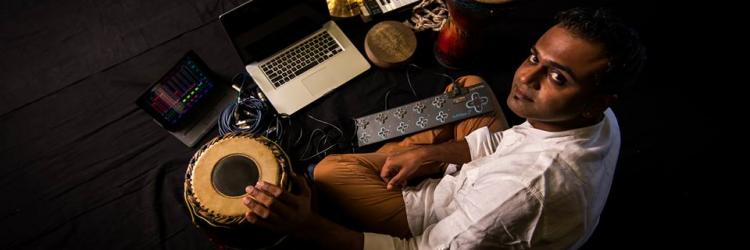How would you describe your sound?
Rooted in its Indianness but also very modern and futuristic.
Tell us about the Gully Boy track “India 91”
I had released a song called Ta Dhom and Ankur Tiwari who is also an artist was working as a music supervisor for the film. So, I met Zoya and she told me that she would like a track like that for the movie. So in short, that’s how the song happened!
How did Ta Dhom project come about?
So, Ta Dhom Project was a personal journey of a different kind for me. I think, classical music for years has been restricted within a certain boundary if I may say so.
If the rappers learnt the Indian system of rhythm, they can use it to write in different flows and also explore time signatures and that was the motivation for them too.
I got a chance to take Ta Dhom project to Europe. It was on my bucket list to perform at Womad and another big festival, Shambala. When the invitation happened, I was in seventh heaven.
It was in many ways a dream come true. Whenever I think about it even now, it feels surreal and seeing the mridangam take centre stage was another hidden dream that i saw come alive.
Taking the rappers and presenting them on big stages was something that I desired from the bottom of my heart, and that happened too.
Thankfully, in these festivals, it’s the music that matters and not “names or surnames”
We also got covered by BBC World Service on Arts hour, BBC 3 and BBC asian network ,which i am so grateful for.
I found out about it in 2008 when I released by first album ‘Moving Images’ and wanted to go, but it’s very expensive.
The first joy happened when we were selected amongst the top 18, out of approx.3000 applications. I am grateful that I found sponsors to get us there.
The audience is from the industry and you actually get briefed about how tough it is to please that audience.
It was through our WOMEX performance that we got invited to Womad, Shambala and a few other festivals.
Can you tell us about SUNOH
Almost 4 years ago, my partner Aishwarya Natarajan and I started SUNOH. It’s basically a brand audio consulting firm. For me personally its an extension of my passion towards music and sound.
I have done about 300 Advertisements in my career. One of the reasons that this felt like a need in the industry, came from the fact that the brief would be very vague and you could say that there was no audio strategy as such. But when it came to colors they were particular about their logo, fonts and so on.
So we started working on how a brand can actually have an Audio DNA ,and a scalable audio strategy
We now also have Tyuns™, a proprietary tool which can show you options of musical notes to build your scale/raga ,by just using the R G B of the color of the brand.
Practise! It’s important to choose the instrument you relate to the most. It is a relationship at the end of the day! It is so important to understand the culture of the instrument you play as well.
Learning the instrument you love, understanding where they come from and the culture is very important to be one with it.








